The biggest part of growing as a coach is the process of your own professional development. Whether that be film study, going to clinics, viewing content online, it plays a role in your growth. Knowledge is power, and the more information you can soak up and apply it to your every day life, the better you become. I began to learn the importance of professional development when I first got into the coaching and it is now a large part of my daily tasks. Below I will share with you my clinic notes that took back in 2016 at the NABC Convention (National Association of Basketball Coaches). I transferred everything I wrote down in a scrappy notebook to a document to help me retain more of the content. Best advice I can give you is to be a life-long learner. Never believe that you know everything. Hope this content helps.
Jared Haase – Stanford Head Coach (former UAB HC)
First things you do taking over a program
- What’s important?
- What’s urgent?
- Build relationships with your players
- Call players before you meet in person (so they can hear your voice)
- Connect with Administrators/Boosters
- Recruit
- Build your staff
- Build a culture
Interviews: Don’t talk about being a coach, talk about being a leader.
Core Values for Program
- Honesty
- Unselfish (Top 5 in the country in assists)
- Loyalty
- Accountability
- Appreciation
“Dream of a coach is for the program to reflect you. Live your dream through your program.”
Leadership – Confidence: How do you gain confidence? Have to work to be good at it. (Demonstrated ability)
Humility – Being humble. No job is too important.
Delegation – Having balance with your stuff: Having thick skin and making tough decisions along with having great relationships with your players.
Relationships*
With your players: They need to know that you care about them and have a level of communication.
Message to young coaches: Do Your Job extremely well and you will succeed.
Phil Martelli – St. Joe’s Head Coach
Practice
- Eliminate whistle: To be better with practice. Have them hear your voice.
- Do you have a plan? Write down your practice plan.
- Must have a plan for the entire season
Use your scoreboard
- Hold team accountable for time and scoreboard
- Build the right habits by using the scoreboard. (Time, score, fouls)
4v4 Change
- Drill used instead of making them run suicides.
- Offensive v. defense: playing until the coach says change. Put the ball your playing with down and have to get back on defense. Team on defense gets another ball from coach and pushes in transition.
What’s better? Doing drills that are a disservice or working on multiple things?
- 3v2, 2v1 or 4v4 transition
- slides or 1v1 baseline cutoff.
Incorporate 1v1 drills into your practice everyday.
Brad Brownell – Clemson Head Coach
Your program has to stand for something
Clemson Basketball stands for defense
- Defensive coverage could change game to game
November-January: Defensive breakdown drills every day.
- Work defensive fundamentals
Defensive breakdown
- As a team
- Post/perimeter
- Game planning
Tiger Closeout:
- Closeout wing (force baseline)
- Chest up on drive – player passes back out to coach – wall up – coach re-drives – spear and recover. (Spear = stunt for Clemson)
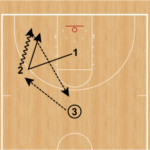
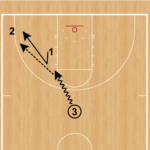
Clemson Zig-Zags
- Full Court
“Kids have to figure things out. If they can’t figure it out, there’s punishment.” (sprint, pushups, etc.) Must communicate.
Defensively
- Dig with inside hand.
- Deflect with outside hand.
Guarding on the ball
*Small guy with speed, get under the ball. Crowd the player with the ball.
*Bigger/ a little slower, give space and jab. Use the sideline.
– Never slide more than 3 times. If you get beat, run and get nose back in front of the ball.
– When you open up hips, players are good enough to spin off and finish. When you get beat, get chest back in front of the ball.
Turn/Pass/Stunt & Recover:

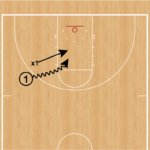
- 1 bounces it out to the slot with x1 following to closeout.
- 1 will inside pivot and rip through attacking middle. x1 is trying to get their chest back in front of the basketball.
Post Breakdown Drill:

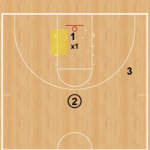
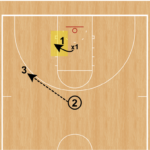

- Shaded area (box): Keep players outside the box. On shot from 3, front pivot block out by x1 to 1.
- Pass to top, butt to the ball locking with both feet on top.
- Eliminate duck in – can get to front on reversal.
- x2 can help and dig when ball is outside the box.
– Play with forearms and elbows = no foul calls
Van Gundy Ball Screen Series:
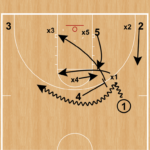

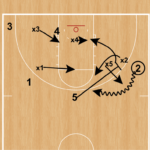

Side Pick & Roll
- Coverage: Under & Attached
- 3 pulled on opposite side
- 2 Fills up to slot
- 5 replaces to top
Second Pick & Roll
- Coverage: Hedge & Under
- 4 tags on x5
- x3 covers down on 4
- x1 pulled in to the nail
Angle Ball Screen
- Coverage: Ice & Plug
- x2 and x4 at nail and split line
Bo Ryan – Former Wisconsin Head Coach
Transition Defense
Get more shots, better than the other team.
Value the ball
Get on the offensive glass – have counter moves – 3,4,5 should make counter move when they get blocked out.
Offense
- Should go through the post
Teach players post moves.
How to get to the FT line? Touch the post
Highest percentage 3?
- Inside/out
- Reb inside/out
Highest percentage shot = Free throw
Transition Defense Continued
- 1stguy back – goalie (1v1)
- Best angle to keep a guy going directly to the rim.
- Big enough, wide enough: best chance to get a stop in a 1v1 situation.
2v1
- Make multiple passes (off.)
- Not chasing back & forth
- Build a castle and hold it down.
- If ball is not stopped x1, x2 stays home and x1 takes pass
- If ball is stopped by x1, x2 can take the pass, x1 stays home with 1
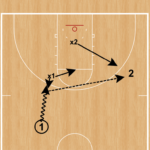
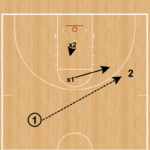
Chris Beard – Texas Tech
Arkansas Little Rock Former HC – NCAA Tourney
Nuggets:
Number 1 Thing: Building Great Relationships with your players.
Not about working hard, it’s about getting things done.
People you think will never help you end up helping you along in your career.
Coaching relationships: Help you for your career.
Philosophy:
- Day 2 day process
- Never talk about winning NJAC/NAT’L Title
- Talk about next game mentality
- Nutrition/Sleep at all levels – players need to feel their bodies.
“Eat with discipline to fuel your body”
Weight Room
- 4-5 days in the offseason
- 3 days in-season
- Lift on the road: hotel or other facility
Film Room: Have guys watch film once a day
- Know your film: Study
- Study other film: NBA, D1, Opponents
Individual Work
- 3:30 guys: Can’t win with those type of guys
- Get workouts in the morning or between classes: spend time away from practice
- 300 Club: Make 300 3’s a day.
Night before Purdue game: Hagan found HS gym to get shots in.
Unselfishness
- What have you done for a teammate today?
- Took a teammate to class
- Took a teammate to the gym to workout
- Brought him food
Discipline
- Every team function: No cell phones
- Have to wear same shirt: Form a bond with your teammates
- No cell phones on the bus
- Team retreat before the season
- Team exercises
- Icebreakers
- Obstacles
Off. Philosophy
- Not trying to win if you don’t constantly talk to your guys – where do they like to score?
- Play like a pro: dribble/pass/shoot
- Start practice everyday:
- Dribble
- Pass
- Shoot
- Finish Shots
- Chart shots
- 80% on finish shots
- Add 2 drillbe/pass/shoot/FINISH
- Don’t let guys dunk in practice – finish!
- Little Rock – 2-1-2 Motion offense
Down Screen
- Curl – trail
- Straight: Shoulder to shoulder
- Flare: Shoot the gap
- They jump the pass: Back cut
Flare – Personnel: Good shooter
- Under: Flare over top
- Jumps it: Middle cut
- Make reads
Defense
- Footwork
- Stance
- Twice a week drill (kill drill)
Kill Drill
- A kill is 3 stops in a row
- Get 7 kills in a game: Win every time
- Team Up (Groups)
- 5 to a team
- 5 have to get 3 stops in a row
- Offense plays freely
- Talk details – Hold accountable – Call every foul – Off. Reb = no stop
Individual Meetings with players every day
- Talk face to face with your players everyday
“If you lie, you’re done”
300 Club
- 300 made 3’s every day
- Bring a guy with you
- Take pics of makes on the gun
More importantly – TRUST
Relationships: Knowing what you want, what they want, get it done.
Tru Pettigrew – Coaching the Millennial Generation
Bridging the Gap
Millennial Perceptions
- Entitled
- Instant Gratification
- Ability to communicate
- Struggle with adversity
Parents
- Parents think there kid is a high D1 player – have never been to a D1 game.
- Next best thing since sliced bread
Millennials connect on importance of passion, purpose, and people
- Connected to people that inspire
Millennials: More than just a ball player
- College 18-21
- New identity formations
- Expanding social circles
- Increased optimism
- Higher education
- Independence
3 things that shape generations
- Parenting styles
- Major societal events
- Geography
Connection Age Attributes – Anchored by the 7 C’s
- Confidence
- Convenience
- Connection
- Control
- Customization
- Collaboration
- Community
3 Key Take-A-Ways
- Meet them where they are
- Love them where they are
- Lead them where they should go
3 Simple Action Steps
- Start with Why? Develop your own program
- Purpose statement – Share it with your players
- Encourage and help them with personal life statements
- Invest your time – Don’t just spend time, invest it.
- Be inclusive – solicit their input on how individual success with understanding of how that contributes to team success. (Feel included. More committed)
- Desire to provide a service
- What you do, where you do it, and how you do it is not important to them.
- Life isn’t the way is should be, it is what it is.
John Moore – Westmount College
Best way to become a leader is to be a good follower
- Learn from other on how to lead
Difference between a team and a program
Team
- Different yr. to yr.
- Stock market
- Bravado and false leaders
- Looking to get “theirs”
- No communication
- Individual stats
Program
- Durable
- Traditions
- Language
- Same players
- Great pride and humility
- Coaches and players communication
- Team stats
- Leaders
Do what you do well and stay with it.
- Honest
- Give your players a WHY
Develop Passing (1 foot)
- Teach pass
- Teach catch
- Teach finish
Greg Herenda – Farleigh Dickinson
252 Drill
- 2 minutes
- 5 shots/5 makes/5 spots
- 25 makes
- Great barometer for shooters
Head Coach – “Treat me like the manager”
“Tell me what I’m doing wrong. How can I get better?”
“Do it your way”
Building A Program
- Develop a staff of great people
- Someone you can trust
“Set your goals high”
After losing 14 out of last 15 games, going into the summer wrote this on the board:
- DAYTON
Be specific with your goals
- This year, wrote “ADVANCE” on the board
Communicate with players all the time
With success becomes major responsibility
- Must be aware
- Right place, right time
Post Defense Drill
- High Side
- Low Side
- Front
“Know your players”
Plan big picture with small steps
-Recruit kids you want, will run what you want.
Change
- If I don’t change, will have another rebuilding year (talking about season after 14-15)
- You will know when you need to change
“Confront, but don’t overreact to adversity”
Play up: Play best competition you can find.
Be patient: Long term patience
Demand Greatness: It will happen
5 Steps to Rebuilding
- Have a clear vision
- Plan big picture: small steps
- Confront: don’t overreact
- Work hard: be patient
- Expect and demand greatness


